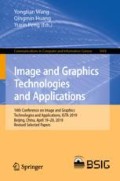Abstract
As working at a video display terminal (VDT) for a long time can induce visual fatigue, this paper proposed a method to use dynamic disparity on the situation of video watching in head-mounted displays (HMD), based on the accommodative training. And an experiment was designed to evaluate whether it can alleviate visual fatigue. Subjective and objective methods were combined in the experiment under different disparity conditions to evaluate the visual fatigue of the subjects. The objective assessment was the blink frequency of the subjects, achieved by the eye tracker. The subjective assessment was questionnaire. However, we came to the conclusion that dynamic disparity caused by the movement of left and right eye images in the HMD can’t effectively alleviate visual fatigue. According to the change of the average eye blink frequency ratio of the subjects during the experiment, the change of the visual fatigue over time was analyzed.
Access this chapter
Tax calculation will be finalised at checkout
Purchases are for personal use only
References
Kroemer, K.H.E., Grandjean, E.: Fitting the Task to the Human: A Textbook of Occupational Ergonomics, 4th edn. Taylor & Francis/Hemisphere (1989)
Yamazaki, T., Kamijyo, K., Fukuzumi, S.: Quantitative evaluation of visual fatigue encountered in viewing stereoscopic 3D display. Proc. Soc. Intell. Des. 31(1), 245–247 (1990)
Takada, M., Miyao, M., Matsuura, Y., Takada, H.: Accommodation training in foreign workers (2013)
Simmers, A.J., Gray, L.S., Wilkins, A.J.: The influence of tinted lenses upon ocular accommodation. Vis. Res. 41(9), 1229–1238 (2001)
Tosha, C., Borsting, E., Ridder, W.H., Chase, C.: Accommodation response and visual discomfort. Ophthalmic Physiol. Opt. 29(6), 625–633 (2010)
Sterner, B., Abrahamsson, M., Sjöström, A.: Accommodative facility training with a long term follow up in a sample of school aged children showing accommodative dysfunction. Doc. Ophthalmol. Adv. Ophthalmol. 99(1), 93–101 (1999)
Arsalan Naqvi, S.A., Badruddin, N., Malik, A.S.: Effects of stereoscopic screen disparity on pupil diamete (2013)
Schor, C.M.: A dynamic model of cross-coupling between accommodation and convergence: simulations of step and frequency responses. Optom. Vis. Sci. 69(4), 258–269 (1992)
Kramida, G.: Resolving the vergence-accommodation conflict in head-mounted displays. IEEE Trans. Vis. Comput. Graph. 22(7), 1912–1931 (2016)
Sherstyuk, A., State, A.: Dynamic eye convergence for head-mounted displays. In: ACM Symposium on Virtual Reality Software & Technology DBLP, pp. 43–46 (2010)
Oskam, T., Hornung, A., Bowles, H., et al.: OSCAM - optimized stereoscopic camera control for interactive 3D. ACM Trans. Graph. 30(6), 1 (2011)
Takeda, T.: Characteristics of accommodation toward apparent depth. Vis. Res. 39(12), 2087–2097 (1999)
Ujike, H., Watanabe, H.: Visual fatigue of viewing stereoscopic display with different ranges of binocular disparity. I-Perception 5(4), 381 (2014)
Kuze, J., Ukai, K.: Subjective evaluation of visual fatigue caused by motion images. Displays 29(2), 159–166 (2008)
Iatsun, I., Larabi, M.C., Fernandezmaloigne, C.: Study of visual fatigue/discomfort generated by S3D video using eye-tracking data. In: IS&T/SPIE International Symposium on Electronic Imaging (2013)
Haraclick, R.M.: Texture features for image classification. IEEE Trans. SMC 3(6), 610–621 (1973)
Ulaby, F.T., et al.: Textural infornation in SAR images. IEEE Trans. Geosci. Remote Sens. 24(2), 235–245 (1986)
Fisher, R.A.S., Bennett, J.H.: Statistical Methods, Experimental Design and Scientific Inference. Oxford University Press, Oxford (1990)
Munafo, J., Diedrick, M., Stoffregen, T.A.: The virtual reality head-mounted display Oculus Rift induces motion sickness and is sexist in its effects. Exp. Brain Res. 235(3), 889–901 (2017)
Kennedy, R.S., Lane, N.E., Berbaum, K.S., et al.: Simulator sickness questionnaire: an enhanced method for quantifying simulator sickness. Int. J. Aviat. Psychol. 3(3), 203–220 (1993)
Yang, F., Yu, X., Huang, J., et al.: Robust eyelid tracking for fatigue detection. In: IEEE International Conference on Image Processing (2013)
Ya-yuan, T.: A fatigue testing method based on machine vision. In: Tan, T., Ruan, Q., Chen, X., Ma, H., Wang, L. (eds.) IGTA 2013. CCIS, vol. 363, pp. 72–77. Springer, Heidelberg (2013). https://doi.org/10.1007/978-3-642-37149-3_9
Luckiesh, M., Moss, F.K.: The eyelid reflex as a criterion of ocular fatigue. J. Exp. Psychol. 20(6), 589–596 (1937)
Yamada, F.: Frontal midline theta rhythm and eye blinking activity during a VDT task and a video game: useful tools for psychophysiology in ergonomics. Ergonomics 41(5), 678–688 (1998)
Kim, D., Choi, S., Park, S., et al.: Stereoscopic visual fatigue measurement based on fusional response curve and eye-blinks. In: International Conference on Digital Signal Processing (2011)
Lambooij, M., Ijsselsteijn, W., Fortuin, M., et al.: Visual discomfort and visual fatigue of stereoscopic displays: a review. J. Imaging Sci. Technol. 53(3) (2009)
George, D., et al.: Accommodation and comfort in head-mounted displays. ACM Trans. Graph. 36(4), 87 (2017)
Konrad, R., Padmanaban, N., Molner, K., et al.: Accommodation-invariant computational near-eye displays. ACM Trans. Graph. 36(4), 1–12 (2017)
Ji, Q., Yang, X.: Real-time eye, gaze, and face pose tracking for monitoring driver vigilance. Real-Time Imaging 8(5), 357–377 (2002)
Jie, G., Dongdong, W., et al.: Subjective and objective evaluation of visual fatigue caused by continuous and discontinuous use of HMDs. J. Soc. Inf. Display 27, 108–119 (2018)
Acknowledgement
The authors would like to thank all the volunteers, and all publications support and staff. This work was supported by the National Key Research and Development Program of China (No. 2018YFB1005002) and the National Natural Science Foundation of China (No. U1605254).
Author information
Authors and Affiliations
Corresponding author
Editor information
Editors and Affiliations
Rights and permissions
Copyright information
© 2019 Springer Nature Singapore Pte Ltd.
About this paper
Cite this paper
Shen, R., Weng, D., Guo, J., Fang, H., Jiang, H. (2019). Effects of Dynamic Disparity on Visual Fatigue Caused by Watching 2D Videos in HMDs. In: Wang, Y., Huang, Q., Peng, Y. (eds) Image and Graphics Technologies and Applications. IGTA 2019. Communications in Computer and Information Science, vol 1043. Springer, Singapore. https://doi.org/10.1007/978-981-13-9917-6_30
Download citation
DOI: https://doi.org/10.1007/978-981-13-9917-6_30
Published:
Publisher Name: Springer, Singapore
Print ISBN: 978-981-13-9916-9
Online ISBN: 978-981-13-9917-6
eBook Packages: Computer ScienceComputer Science (R0)

